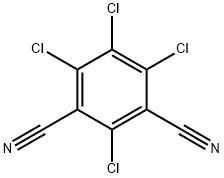1897-45-6

Product Name:
Chlorothalonil
Formula:
C8Cl4N2
Synonyms:
TRN;KPNB2;MIP1;Tetrachloroisophthalodinitrile;TNPO1
Inquiry
CHEMICAL AND PHYSICAL PROPERTIES
| Physical Description | Chlorothalonil appears as colorless crystals or granules or light gray powder. Melting point 250-251 °C. No odor when pure; technical grade has a slightly pungent odor. A fungicide formulated as water-dispersible granules, wettable powder, or dust. |
|---|---|
| Color/Form | Colorless crystals |
| Odor | Odorless in pure form |
| Boiling Point | 662 °F at 760 mmHg (NTP, 1992) |
| Melting Point | 482 to 484 °F (NTP, 1992) |
| Solubility | less than 0.1 mg/mL at 70 °F (NTP, 1992) |
| Density | 1.7 at 77 °F (NTP, 1992) - Denser than water; will sink |
| Vapor Pressure | less than 0.01 mmHg at 104 °F ; 9.2 mmHg at 338.7 °F (NTP, 1992) |
| LogP | log Kow = 3.05 |
| Henry's Law Constant | Henry's Law constant = 2.5X10-7 atm-cu m/mole at 25 °C |
| Stability/Shelf Life | Thermally stable at ambient temperatures. Stable to u.v. light in aqueous media and in crystalline state. Stable in acidic and moderately alkaline aqueous solutions; slow hydrolysis at pH >9. |
| Decomposition | May decompose at high temp to emit hydrogen chloride. |
| Corrosivity | Non-corrosive |
| Kovats Retention Index | 1787 1776.1 1808.8 1829 1786.2 1779.2 |
| Other Experimental Properties | Stable to ultraviolet radiation. Nonvolatile under normal field conditions |
| Chemical Classes | Pesticides -> Fungicides |
SAFETY INFORMATION
| Signal word | Danger |
|---|---|
| Pictogram(s) |
 Corrosion Corrosives GHS05  Skull and Crossbones Acute Toxicity GHS06  Health Hazard GHS08  Environment GHS09 |
| GHS Hazard Statements |
H317:Sensitisation, Skin H318:Serious eye damage/eye irritation H330:Acute toxicity,inhalation H335:Specific target organ toxicity, single exposure;Respiratory tract irritation H351:Carcinogenicity H410:Hazardous to the aquatic environment, long-term hazard |
| Precautionary Statement Codes |
P202:Do not handle until all safety precautions have been read and understood. P273:Avoid release to the environment. P280:Wear protective gloves/protective clothing/eye protection/face protection. P302+P352:IF ON SKIN: wash with plenty of soap and water. P305+P351+P338:IF IN EYES: Rinse cautiously with water for several minutes. Remove contact lenses, if present and easy to do. Continuerinsing. |
COMPUTED DESCRIPTORS
| Molecular Weight | 265.9 g/mol |
|---|---|
| XLogP3 | 2.9 |
| Hydrogen Bond Donor Count | 0 |
| Hydrogen Bond Acceptor Count | 2 |
| Rotatable Bond Count | 0 |
| Exact Mass | 265.878609 g/mol |
| Monoisotopic Mass | 263.881559 g/mol |
| Topological Polar Surface Area | 47.6 Ų |
| Heavy Atom Count | 14 |
| Formal Charge | 0 |
| Complexity | 284 |
| Isotope Atom Count | 0 |
| Defined Atom Stereocenter Count | 0 |
| Undefined Atom Stereocenter Count | 0 |
| Defined Bond Stereocenter Count | 0 |
| Undefined Bond Stereocenter Count | 0 |
| Covalently-Bonded Unit Count | 1 |
| Compound Is Canonicalized | Yes |
PRODUCT INTRODUCTION
description
Chlorothalonil appears as colorless crystals or granules or light gray powder. Melting point 250-251 °C. No odor when pure; technical grade has a slightly pungent odor. A fungicide formulated as water-dispersible granules, wettable powder, or dust.
RELATED SUPPLIERS
Ekhande Agro Fertilizers Private Limited
Maharashtra
product:Powder Spenit Chlorothalonil 75% WP, Packaging Size: 500 g
